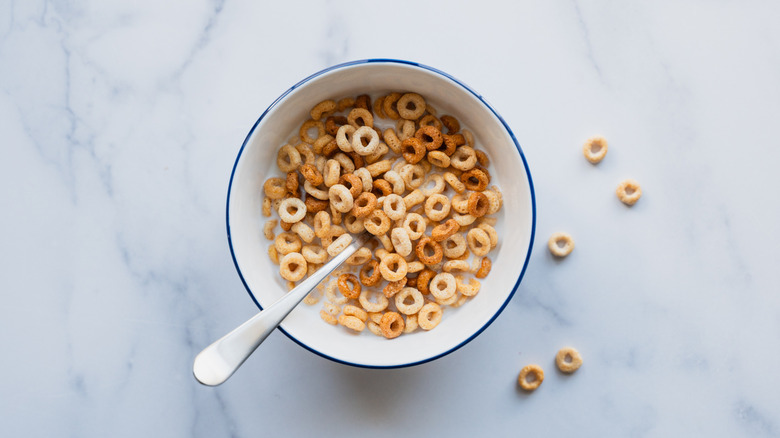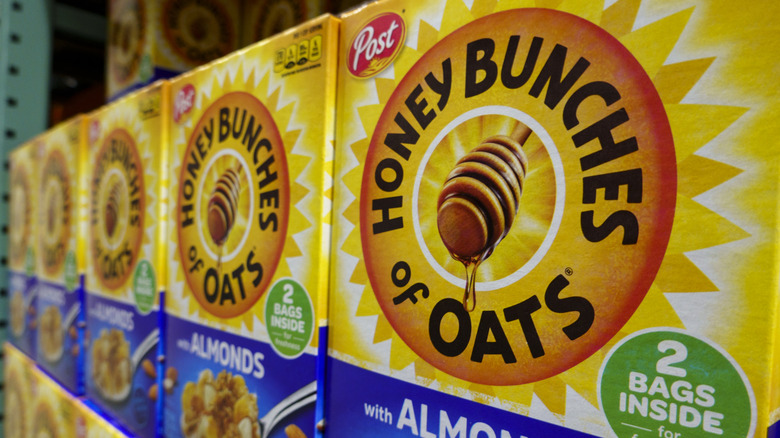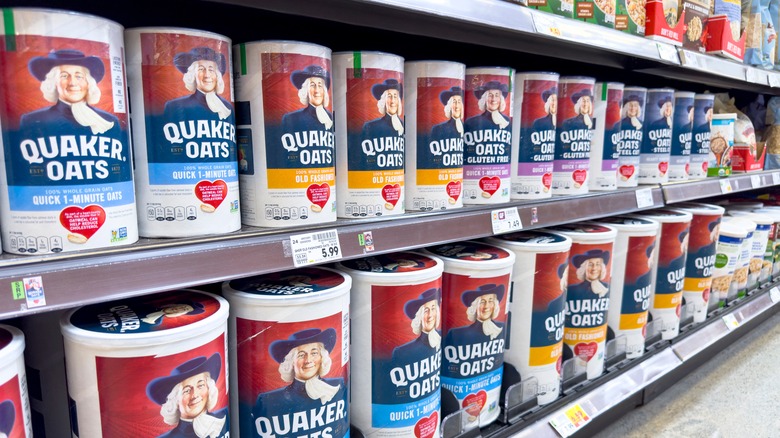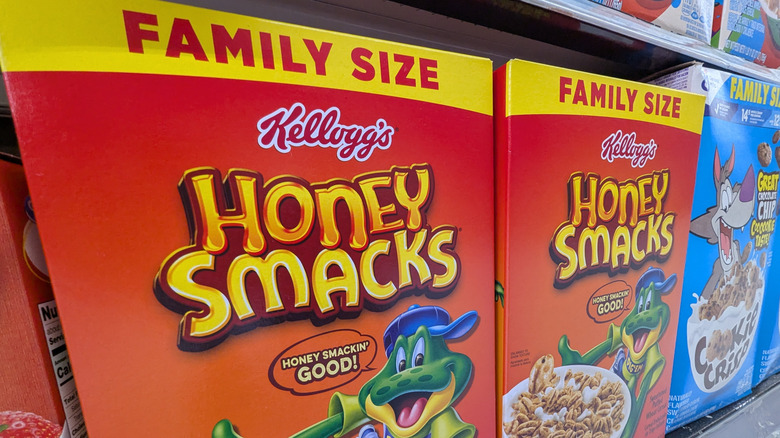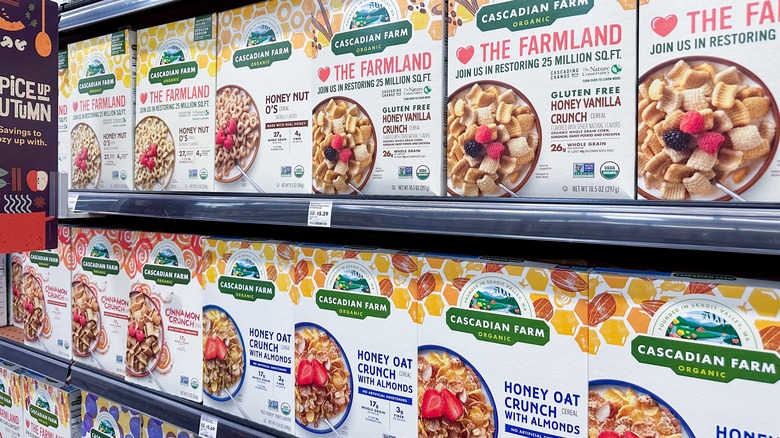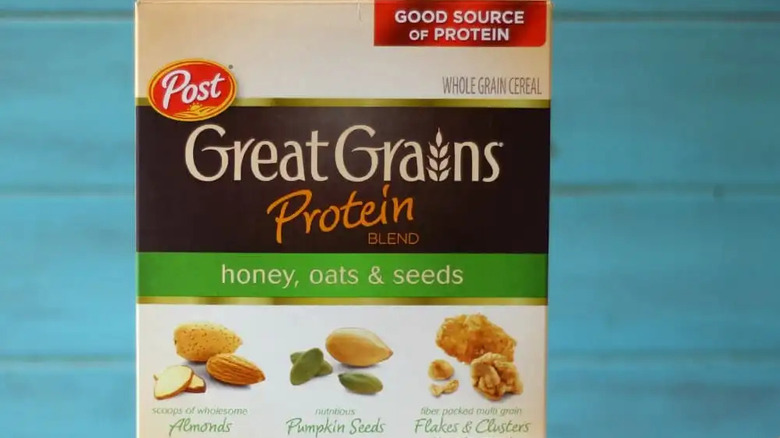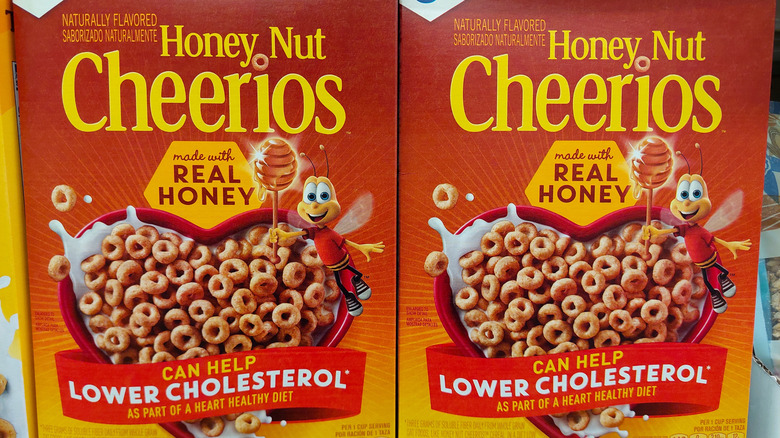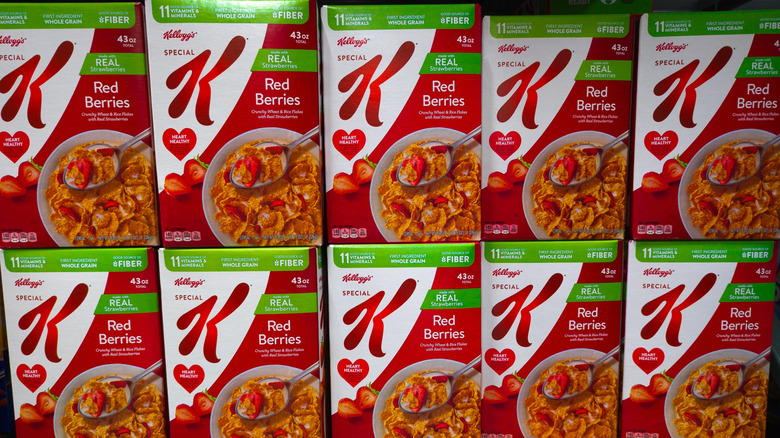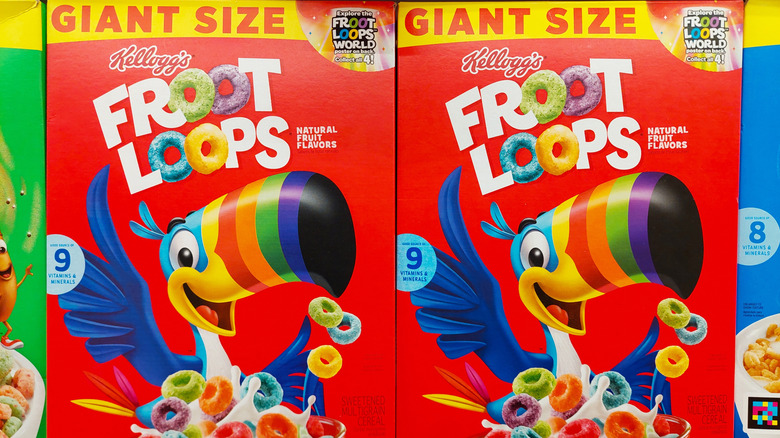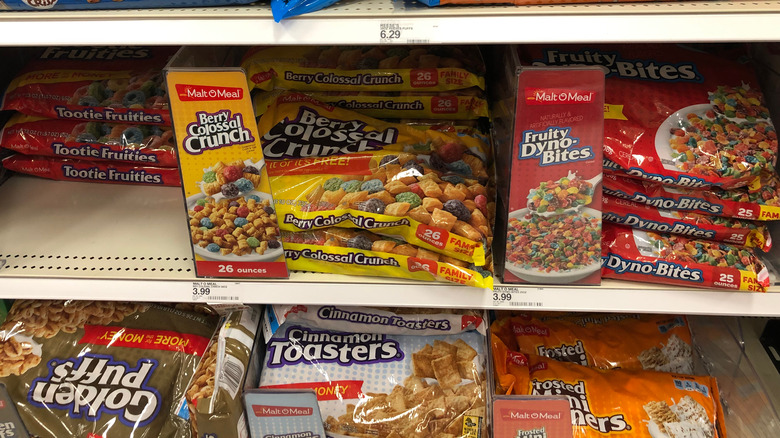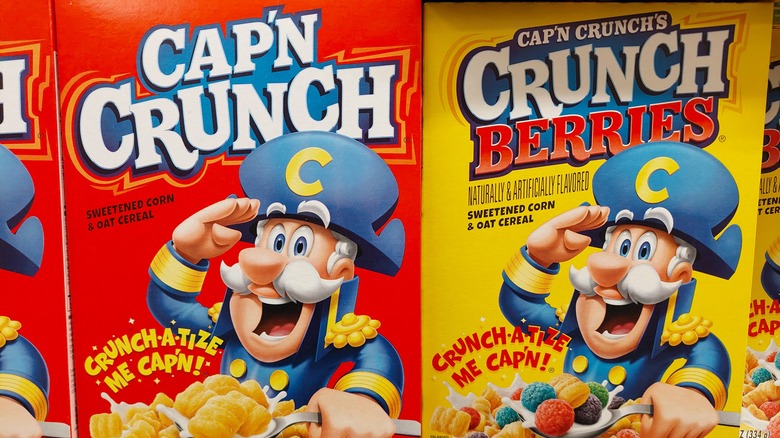The 10 Worst Cereal Recalls To Ever Hit The US
Breakfast cereal is a staple for millions of Americans. Whether you're a fan of sugary Froot Loops or a healthier granola, you've likely been eating your favorites for years. But some of the classic and most well-known cereals have made headlines over the years for all the wrong reasons. Spanning back to the 1980s and beyond, there have been several alarming cereal recalls that have swept the U.S., forcing major corporations to evaluate the safety of their products.
These recalls have done major, and in some cases, irreparable damage to leading companies. From listeria contaminants to metal and glass being found in boxes to a hazardous toy for kids, there have been several reasons why the brands you know and love have been pulled from the shelves. Here we will take a look at some of the most notable and memorable cereal recalls the United States has seen so far.
Honey Bunches of Oats (2025)
In a stunning event from earlier this year, Post recalled thousands of boxes of Honey Bunches of Oats with Almonds due to the discovery of metal pieces in the cereal. This has been one of the more severe recalls reported in recent memory, as these metal fragments could cause medical issues such as chipped or cracked teeth, as well as internal blockages and puncture wounds from the metal. While Post Consumer Brands suggested that the issue was caught before the boxes of cereal hit the shelves, the FDA still issued a warning encouraging customers to check the dates on their boxes of Honey Bunches of Oats with Almonds to make sure they didn't have a potentially affected box.
The FDA classified this as a Class II recall, indicating that ingesting this cereal "may cause temporary or medically reversible adverse health consequences." Physical contamination can be the result of plastic, metal wire, or other materials being found in food producers. Metal contamination is usually a result of a machine malfunction somewhere on the manufacturing line. It is important to thoroughly check your food, especially food that has been processed or pre-packaged, to be on the safe side.
Quaker Products (2023-2024)
You may recall a massive Quaker recall that stands out to many due to its prolonged duration. While the initial recall was released in late 2023, it spanned into 2024, with the list of recalled products ever-expanding. The cause of this recall was a salmonella outbreak that was found in its granola, hot cereal, and other oat-based products. This virus didn't affect just one cereal, like most of the other recalls listed here, but resulted in dozens of Quaker's products being pulled from the shelves for several months. Even after Quaker was listed as safe, customers were wary about purchasing this brand after such a large health hazard.
This recall was shocking to many because consumers often assume that their favorite large brands are generally safe. Salmonella infections can be incredibly severe, especially for children and the elderly. No infections were reported, but the risk was enough for the FDA to issue an urgent warning for people to avoid these goods. This recall affected not only grocery stores but also larger retail stores such as Walmart and Target.
Honey Smacks (2018)
In 2018, Kellogg's Honey Smacks were recalled due to a massive salmonella outbreak. This was a hugely widespread recall, affecting over 100 customers in 36 states. This outbreak didn't just affect U.S. customers, though. Honey Smacks are internationally distributed, so people in countries such as Guatemala and Costa Rica experienced ill effects. The FDA promptly advised customers to remove this item from their pantries to be safe. Although salmonella is most commonly found in poultry products, it can be found in grains and other processed foods.
This was not the first time that this particular cereal suffered a recall, but it was the most widespread in the brand's history. This recall was especially troubling because even though all of the cereal was made in the same place, the distribution was so wide that people across both state and national borders suffered due to the salmonella contamination. Preventing food-borne illness can be difficult in mass-produced facilities, but this instance proves how important quality checking and quick recalls can be.
Cascadian Farms Granola (2017)
Cascadian Farms is known for being a health-conscious choice, so its consumers were shocked when the brand issued a voluntary recall in 2017. Unlike many other recalls, this one wasn't due to bacteria or another contamination, but instead due to almonds making their way into the mix when they were not declared on the label.
The average buyer may not think much of this mishap, but to those with a nut allergy, this mistake could be fatal. Those with food allergies and intolerances are used to diligently checking labels for everything they consume. How frustrating, then, to find out that a major allergen had snuck into a product without anyone knowing. Allergen labeling issues are most common with cereal and pasta recalls, due to their large production scales. This failure to list a major allergen as an ingredient is a major FDA violation, and the company quickly pulled the product from the shelves. Luckily, no illnesses were reported, but this could have easily become a major health hazard for the nearly 4 million U.S. citizens who are allergic to tree nuts.
Great Grains Protein Blend – Honey, Oats & Seeds Cereal (2016)
In 2016, Post Consumer Brands issued a voluntary recall of its Great Grains Honey, Oats & Seeds Cereal due to a possible Listeria monocytogenes contamination. This cereal contains sunflower seeds sourced from another supplier, SunOpta, and it was this ingredient that was found to be potentially contaminated. The sunflower seed vendor issued its own voluntary recall after discovering that its product could potentially be contaminated, so Post was forced to recall its cereal, as well. Listeria poses an extreme health risk to anyone, but particularly to children and the elderly.
Fortunately, because Post acted quickly and disposed of the potentially affected batch of cereal, no illnesses were reported. This was lucky, as many recalls do not have such a safe conclusion. Customers were alerted so that they could throw out any cereal that may have been part of the affected batch. The supplier was the source of ingredients for several large brands, so this recall has the potential to become a widespread health risk if it hadn't been caught early.
Cheerios (2015)
General Mills was plastered across headlines in perhaps the biggest fumble of them all. In 2015, it was discovered that 1.8 million boxes of gluten-free Cheerios and Honey Nut Cheerios were not actually gluten-free. This incredible labelling mistake was made at the General Mills plant in Lodi, California, where the product was contaminated with wheat. As with other allergens, this was a severe risk for those with celiac or gluten intolerance. Similar to other cross-contamination recalls, there were dozens of illnesses reported before General Mills finally removed the affected boxes from grocery stores.
This mistake made a damaging mark on General Mills, as it had just rolled out a huge marketing campaign for its gluten-free products, and the label was prominently displayed on its packaging. The brand was viewed as a healthy choice for those making health-conscious choices or those who had dietary restrictions, so this demographic was disappointed when they felt they could no longer trust the brand.
Special K Red Berries (2013)
Kellogg's again was at the center of a disturbing recall in 2013 when customers reported small shards of glass in their Special K Red Berries cereal. Over 36,000 boxes of cereal were disposed of when Kellogg's fell under yet another investigation. The brand went so far as to issue a public statement and offer customers refunds if they'd bought boxes that were in the batch affected by the recall.
Although Kellogg's insisted that the recall only applied to one affected batch, it watched its sales of Special K Red Berries temporarily dip. While the exact source of the glass shards was never identified, the brand had to do a full sweep of its equipment and production lines. These types of recalls, where physical contaminants are present, are rarer, but they are arguably much more serious, as ingesting things like metal or glass can lead to extreme health complications.
Kellogg's Froot Loops (2010)
In a bizarre event in 2010, Kellogg's recalled popular cereals like Froot Loops (which, do different colored Froot Loops have their own flavors?) due to a strange substance that was leaking from the packaging into the cereal. This sweeping recall of over 28 million boxes of cereal also included Apple Jacks and Corn Pops, as they were all packaged in the same facility in the same manner. Consumers not only reported strange tastes and smells coming from their cereal boxes, but after ingesting, many gastrointestinal difficulties were also reported. Upon investigation, it was found that a petroleum-based compound, methylnaphthalene, was leaching into the cereal from the wax-coated packaging.
Kellogg's tried to insist that this compound was no major cause for concern, but, actually, methylnaphthalene has been the subject of many FDA health-related investigations. This recall caused wariness in consumers, as they no longer felt like their food was being packaged in a safe way. This caused skepticism for many brands and products that were pre-packaged, and Kellogg's was forced to up its safety standards on not just its product, but packaging, as well.
Malt-O-Meal (1998)
Malt-O-Meal is known for being more affordable than brand-name favorites, but it's also known for an earth-shattering recall in 1998, one of the most severe in U.S. history. An entire batch of toasted oat cereal was recalled after a salmonella outbreak caused more than 200 people across 11 states to fall sick. Many were even hospitalized after the infections. The infection began in a single production plant, and this plant was fully investigated by the CDC. Consumers were disheartened, feeling that perhaps the bargain brand was more unsafe than the brand-name items.
This recall alarmed consumers because it took a particularly long time to identify where the infected product was coming from. Many people had fallen ill and been hospitalized before the plant was identified. The contamination came from one single facility, and the company fell under fire due to delayed response times and its less-than-stellar quality control.
Cap'n Crunch (1993)
Back in the early '90s, Cap'n Crunch went under fire not for its cereal, but for what was included in the box alongside the cereal. The '90s came with a surge of what became a breakfast norm — adding a toy inside the box. During this particular recall, the brand was including a small rubber ball-type toy, which, upon first look, seemed harmless, but actually had a suction property that proved dangerous for the children who were using it. Kids were putting the toy up to their eyes and then using the suction feature on the toy by mistake, causing bloodshot and irritated eyes among children.
This raised major red flags about product safety and what kind of quality control the toy had been through before Cap'n Crunch started including it in its boxes. There were many complaints from anxious and outraged parents, and pediatricians eventually got involved, as well. After this surge of backlash, the toy was removed from all future boxes, and the process for testing the safety of these prizes became more diligent.

